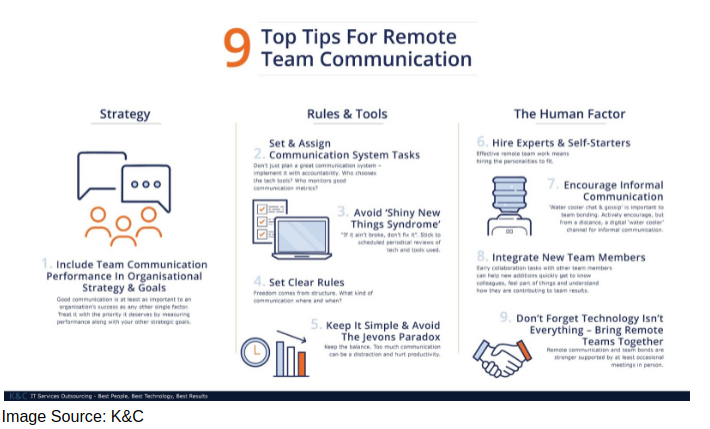Communicate visually with your remote team
Sign up for a free 14-day trial and start collaborating with your team! No credit card required.

Table of Contents
ToggleWith remote working becoming a permanent solution for many businesses, finding ways to improve communication is more important now than ever.
Whereas there are several benefits to working from home, for employers as well as staff, remote team communication must be optimized to ensure productivity and effective collaboration.
It’s also essential to help strengthen professional relationships and boost employee well-being.
There have been negative effects on remote team communication due to the pandemic. Employees have had to adjust to different ways to communicate, involving technology such as video conferencing software, for example.
Where many businesses have adapted to this quickly, the onboarding of such software can take time.
The pandemic has also resulted in a lack of in-person contact at work, which many employees may miss. 19% of remote workers have reported loneliness as their biggest challenge.
Certain companies are socializing less as a group and having fewer catch-ups than they would in the office.
Lockdown restrictions have also impacted employee mental health and without better communication, this could affect productivity and staff morale.
Another important factor to consider is that many businesses have begun hiring remotely. New members of staff start working without even having met the rest of the team.
It’s essential to improve communication for the successful training of these employees and to ensure they are welcomed into a positive environment.
This could create a barrier between new and existing members of staff if not, and line managers need to ensure all new employees are confident and comfortable.
Working remotely, all members of staff will no longer have access to other forms of communication and in-house amenities for socializing.
These include meeting during the lunch hour at the cafeteria, chatting at the water cooler, or taking casual coffee breaks.
This can result in more pressure being put on team leaders to ensure that members of staff are making the effort to communicate effectively through more organized methods.
Fortunately, technology has been a great help and many businesses have adjusted to this new way of doing things.
There are also companies that were used to remote work as a standard way of operating even before the pandemic. We can benefit from some great insights from how they’ve created systems and mechanisms over years to keep communication flowing well and retain a collective team identity.
Nearshore IT outsourcing company K&C have put together the following infographic of their top tips and tricks for remote work, developed over more than 20 years now:

Meeting at the water cooler, proverbial or not, is a way for staff to interact on a more casual basis. This can be quite productive as well as having social benefits. Employees can discuss ideas more freely and engage their creativity.
The question is, how can you recreate water cooler moments remotely?
Certain businesses have created a virtual water cooler by organizing individual or group chat channels. There are also plenty of collaboration tools such as Slack which even has a water cooler feature designed for this specific purpose.
There is actually a bot that pairs up your online team members and encourages them to chat about something that’s not work-related.
Companies can also use an internal blog format or an open-discord channel for free conversation. Others may organize social events or team-building activities to boost communication.
Recreating the natural communication that occurs at the water cooler may be a challenge, but as employees adapt to new ways of speaking to their co-workers, these could become the norm.
Changes in remote team communication have led to managers rethinking the way to do things. Rather than holding larger and longer meetings, it’s better to have shorter meetings relating to a specific topic.
There are always too many meetings happening and you should fix this if you know it’s happening in your team as well.
This way only the relevant team members need to attend and this reduces the number of people on a video call, for example. This would also be beneficial for in-person work as many teams are figuring out ways to use time more effectively during meetings.
One of the main benefits of working remotely is staff flexibility and changing the way we do meetings can help.
Remote staff can free up their agenda for more important meetings and get on with the task at hand, rather than attending larger group calls. It’s also possible to be more flexible with working hours.
Employees working in a “hybrid” situation between the office and home can then choose which days are more important to come in.
To optimize remote team communication during meetings, it’s more important to follow a structure. Meetings need stricter agendas and it’s important that all members of staff, especially those leading, adhere to these.
The main reason for this is that there is a certain barrier when it comes to communicating remotely, due to technical issues for instance. If all team members are given a meeting agenda this will make it much easier to follow and participate.
There are plenty of advanced and productive apps that make agendas for teams. Two of the most popular include Notion and Hugo.
These are both centralized tools that allow for better collaboration during meetings. You can organize meetings and tasks to a strict agenda and take notes as well. These cloud-based apps have helped to improve team communication remotely.
For more unstructured tasks, remote teams can also use digital whiteboards such as Miro and Kdan Mobile’s NoteLedge. These help team members to visualize and share their ideas even if they are all in different locations.
This allows for engagement on a deeper level while brainstorming and employees can bounce ideas off one another. It is, of course, essential to train remote staff to ensure they are confident using this new type of software.
Without the natural levels of structure in a physical working environment, for example, breakrooms, spaces between cubicles, the copy machine area, front entry, or labs, it’s necessary to provide different levels for asynchronous communication.
More structured forms of communication can include email, memos, calendar event details, and discussions. In this stage, it’s important to implement DMARC configuring to ensure secure email communication.
These allow for more organized and accessible communication. It’s easier for remote staff to plan their working days around these but there are also different ways to provide less structured communication.
Standups, whether they’re daily, weekly, or monthly can be semi-optional and allow members of staff to get a bit more general information on what their co-workers are doing. Several apps and programs have features to enable this.
Slack has plugins such as Standup and Prosper which can be very useful in this case. To provide more in-depth information asynchronously other tools such as Loom or Vmaker videos can be used.
Comment threads have also proven to be very useful for remote team communication. These are present on the majority of common remote working apps. You can view in-line comments in Google Docs, comment summaries in Asana or Notion, and daily comment email digests.
Even though several different apps offer this feature, it’s more efficient to use a centralized communication app rather than a variety of programs. To follow remote communication best practices, opt for one complete app that includes DMs, channels, files, reactions, threads, and permissions, all being vital features.
If centralized communication apps such as Slack aren’t sufficient for your business’s operations you could consider upgrading to tools that make it easier to share comments quickly.
If you need to mark issues and provide feedback on your team’s work in real-time, try zipBoard, for example. It allows you to get asynchronous, visual feedback on your project work.
To improve remote team communication, it’s necessary to maintain a healthy balance. This includes explicitly setting working hours and times for communication, for instance. It’s also important to provide your remote employees with a do-not-disturb option, ideally at set times.
During conference calls, ensure your staff follows guidelines about keeping their camera and microphone switched on.
It might be necessary to hold training sessions on video call etiquette to ensure everyone is on board. Black screens and silence aren’t great for small teams as the level of communication is reduced.
Aim to limit DM-ing as many conversations would be more helpful if they’re heard by the rest of the team.
To train your employees in best practices, give them examples of topics that are more suitable for DMs both between them and their boss, and with clients.
This information should be included as part of onboarding new staff. It will help to set boundaries and boost overall productivity, along with employee well-being.
There are several other ways to boost employee morale and strengthen relationships. Playing games such as Among Us can be a great team-building activity, for example, or setting up design challenges if you’re in the design industry.
To maintain a balance it’s important to differentiate between optional and billed time and to get plenty of feedback from your staff.
Here are a few more tips on how to be a better remote leader in 2021
How businesses are operating is constantly evolving and more companies are adapting to a remote or hybrid situation. To boost collaboration, you need to keep up with the current trends and adopt more effective remote team communication strategies.
This is essential to maximize both staff productivity and morale. For more information about how you can improve your remote team communication for your business, click here.
 Darya Jandossova Troncoso is a photographer, artist, and writer working on her first novel and managing a digital marketing blog – MarketSplash. In her spare time, she enjoys spending time with her family, cooking, creating art, and learning everything there is to know about digital marketing.
Darya Jandossova Troncoso is a photographer, artist, and writer working on her first novel and managing a digital marketing blog – MarketSplash. In her spare time, she enjoys spending time with her family, cooking, creating art, and learning everything there is to know about digital marketing.
Sign up for a free 14-day trial and start collaborating with your team! No credit card required.
©️ Copyright 2025 zipBoard Tech. All rights reserved.